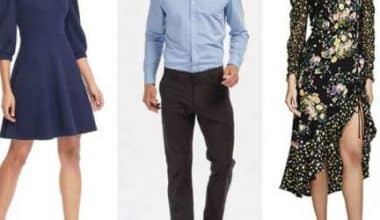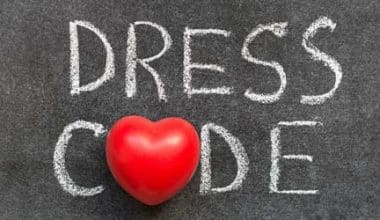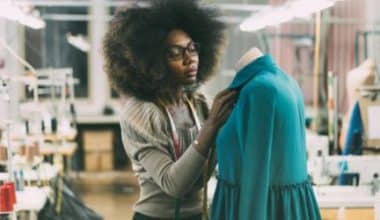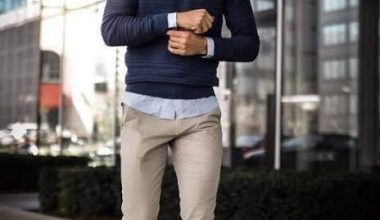Dressing in business professional attire is essential for many professionals because it can affect how they are seen at work. Many a time, how we dress speaks volumes about who we are and what we represent. A person’s dress can significantly affect how others perceive them, especially in business. To project a professional image, you must wear professional business attire, and you should know what that looks like.
What Is Considered Professional Business Attire?
Usually, professional business attire is worn at work, during job interviews, or in business meetings. The following are some guidelines for professional business attire:
#1. Suits
A suit is considered the most formal business professional attire for both men and women. A well-tailored suit in a conservative color such as black, navy, or gray is appropriate.
#2. Dress Shirts
For men, a button-down dress shirt is appropriate. Women can also wear button-down dress shirts or blouses.
#3. Pants or Skirts
Pants for men and women should be tailored and fit well. For women, skirts should be knee-length or longer.
#4. Dresses
Women can wear dresses, but they should be professional and modest, with a hemline at or below the knee.
#5. Shoes
Closed-toe shoes are recommended, with dress shoes being the most appropriate. For women, low-heeled shoes are preferable.
#6. Accessories
Accessories should be kept to a minimum, with a watch, belt, and simple jewelry acceptable. Avoid anything too flashy or distracting.
It’s important to note that the specific dress code for professional business attire for men and women can vary by industry and company. When in doubt, it’s always best to dress more conservatively and err on the side of being too formal rather than too casual.
What Are the Four Types of Professional Attire?
The four types of professional attire are:
#1. Business Formal
This is the most formal type of professional attire for men and women, often required for black-tie events, formal dinners, and high-level business meetings. Men should wear a black or dark-colored suit, a white dress shirt, and a conservative tie. Women should wear a tailored suit or dress, and accessories should be minimal and conservative.
#2. Business Professional
This is the standard dress code for many professional settings, including corporate offices and job interviews. Men should wear a suit and tie, while women should wear a tailored dress, skirt, or pants with a blouse or dress shirt. Neutral colors such as black are ideal for plus size for professional attire.
#3. Business Casual
This dress code is less formal than a business professional’s but still requires a professional appearance. Men can wear dress pants or khakis with a dress shirt or sweater, while women can wear a blouse with dress pants, a skirt, or a dress. Avoid sneakers, shorts, and T-shirts.
#4. Smart Casual
This more relaxed dress code is appropriate for creative or casual work environments. Men can wear dress pants or chinos with a dress shirt, while women can wear a blouse with dress pants, a skirt, or a dress. Accessories can be playful and colorful, but avoid anything too casual, such as flip-flops or athletic wear.
Here Are Some Possible Approaches to Professional Business Attire in 2023:
- Prioritize Comfort: With comfort being a key pillar of office dressing in 2023, choosing clothing and shoes that feel good throughout the day is essential. This could include stretchy slacks, sweater jackets, and comfy loafers.
- Showcase Personal Style: While there is no one-size-fits-all approach to professional business attire, it’s important to showcase your style. This could include feminine blouses with ruffles, minimalist patterned pants, or unique accessories.
- Consider the Occasion: Dress codes can vary by industry and environment, so it’s essential to consider the occasion when choosing what to wear.
- Be Professional: Regardless of personal style or the occasion, it’s essential to maintain a professional appearance. This could include wearing high-quality fabrics, classic styling, and conservative necklines and accessories.
- Choose Appropriate Shoes: When it comes to business casual shoes for men, it’s essential to choose shoes appropriate for the outfit, occasion, and desired level of formality.
Dressing for Your Industry
It’s essential to think about how people in your industry dress. What’s appropriate in a tech startup may not be the same as what’s appropriate in a law firm. Make sure you understand the expectations for attire in your industry and tailor your wardrobe accordingly.
Dressing professionally in 2023 doesn’t mean sticking to the same old suit and tie. Instead, it’s about finding the right mix of formal and casual clothes that are still right for your industry.
Does a Business Professional Require a Jacket?
Business professional attire for men and women combines business formal and business casual. It is typical to wear dress slacks and a collared shirt or blouse without a jacket or tie instead of a full business suit. Still, often, business professional attire involves a jacket. It is crucial to note that one may not always be required to wear a jacket, but having one available for scenarios such as board meetings or interacting with high-profile clientele is advisable.
What Does Professional Business Attire Look Like on a Woman?
Professional business attire for women can be different depending on the industry, the culture of the workplace, and the rules about what to wear. But some general rules can help women create a polished and professional look for the office.
#1. Choosing an Attire
Choosing clothing that is well-fitting and not too tight or revealing is essential. Clothing should be comfortable to wear and allow for ease of movement, but it should also convey a sense of professionalism and competence.
- A tailored suit with a blazer and pants or a skirt is a classic and timeless choice.
- Neutral colors such as black, gray, and beige are safe and versatile choices, but bolder colors such as red or green can also work depending on your workplace.
- Avoid bulky outfits as plus size; instead, wear more layered outfits for your professional attire.
- Opt for a dress or skirt at or below the knee for a feminine touch. A modest neckline and avoiding sleeveless or low-cut styles are also recommended.
- Keeping the outfit conservative and flattering is essential, especially for job interviews.
- Women should aim for a tailored silhouette for their professional business attire.
- For the plus size, your professional attire should be more of dress pants
#2. Choosing a Footwear
- Closed-toe shoes with low to medium heels are appropriate for most workplaces.
- Neutral colors such as black, brown, and beige are safe options, but a pop of color or pattern can also work depending on the workplace culture.
#3. Choosing Accessories
- Keep your accessories simple and minimal. A watch, simple earrings, and a necklace can add a touch of elegance without being too distracting.
- Avoid excessive jewelry or anything too flashy.
- Add luxury accessories to your professional attire as a plus size to elevate your look
Generally, women and men should wear professional business attire that shows they are competent, confident, and professional. It’s important to dress appropriately for the workplace and feel comfortable and confident in your clothing choices. By following these general rules, women can create polished, professional business attire for the office.
What Not to Wear for Business Professionals?
As a business professional, it’s essential to project a polished and professional image in the workplace. While fashion trends constantly change, some clothing items and styles are inappropriate for a professional setting. Here are some examples of what not to wear as a business professional:
#1. Casual Clothing
Clothing that is too casual, such as ripped jeans, shorts, t-shirts, or sweatpants, should not be worn in the workplace. This type of clothing is generally seen as unprofessional and can give the impression that you are not taking your job seriously.
#2. Revealing Clothing
Clothing that is too revealing, such as low-cut tops, short skirts, or see-through clothing, should also be avoided in the workplace. This type of clothing can be distracting and inappropriate for a professional environment.
#3. Loud Prints or Patterns
While a pop of color or pattern can add interest to an outfit, clothing with loud prints or patterns can be distracting and unprofessional. Sticking to solid colors or subtle patterns when dressing for work is best.
#4. Overly Casual Footwear
Sneakers, flip-flops, and sandals are generally inappropriate for a professional setting. Instead, opt for closed-toe shoes with low to medium heels.
#5. Excessive Accessories
While accessories can add interest to an outfit, it’s important not to overdo it. Avoid wearing too much jewelry or accessories that are too large or flashy.
#6. Wrinkled or Stained Clothing
Finally, ensuring your clothing is clean, pressed, and free from wrinkles or stains is essential. Clothing that is wrinkled or stained can give the impression that you are disorganized or do not take your job seriously.
By avoiding these clothes and styles, you can ensure you have a professional look at work and keep your coworkers’ and clients’ respect and credibility.
The following are some of the things you should not wear as a business professional:
- Yoga pants and leggings
- Light-wash or ripped jeans, unless you work in a genuinely casual outfit
- Clothes that don’t fit properly, including those that are too baggy or overly tight
- Clothes that are dirty, wrinkled, or too provocative
- Chunky jewelry or any jewelry that makes noise when it moves, oversized belts, or a busy tie
- Jeans, unless expressly indicated by your human resources department – if permitted, wear only straight-cut and dark-washed jeans
- Bright patterns or low-cut tops
- Denim cuts that are too casual, like flare jeans or cutoffs
- Too casual shoes like flip-flops or sneakers
What Colors Are Professional in Business?
Colors can play an essential role in the professional world. The right colors can give an office a professional and put-together look, boost energy, and boost confidence. Additionally, colors express a variety of non-verbal messages, which can be authoritative or approachable. The following are some colors that are considered professional in business, according to the sources:
#1. Neutral Colors
Neutral colors such as black, white, navy, gray, and beige are always safe and professional choices. These colors are versatile and can be easily paired with other colors or accessories. Professional attire for plus size should be more neutral colors.
- Black: It can make you appear sophisticated, powerful, assertive, strong, commanding, and mature. It is a more acceptable color in a formal business setting
#2. Conservative Colors
Colors such as dark blue, burgundy, and forest green are also considered professional in business settings. These colors are subtle yet sophisticated and convey a sense of professionalism and competence.
- Blue: It is a classic business attire color associated with trust, stability, and reliability. It is a safe, conservative color appropriate for almost any business setting.
#3. Earthy Tones
Earthy tones such as tan, olive green, and rust can also be professional in the right setting. These colors convey a sense of warmth and approachability and can be paired with neutral colors for a polished look.
- Brown: It is a warm, earthy color associated with stability and reliability. It is a good choice for a casual business setting.
#4. Pastels
Pastel colors such as light blue, pink, and lavender can also be professional in specific industries or settings. Light and refreshing colors can be paired with neutrals for a balanced look.
- Lavender: This color evokes energy and action and is suitable for creating an engaging workspace.
#5. Bold Colors
While bold colors such as red, yellow, and bright green can be professional in some industries or settings, it’s essential to use them sparingly and pair them with neutral colors for a balanced look.
- Red: It is associated with high energy, strength, and physicality. It can be well-suited for fast-paced work environments that require physical exertion. It can also make you appear aggressive, dominant, and dynamic.
Thinking about the style, industry, and workplace culture is essential when picking business colors. Different situations and industries will accept varying dress codes, and some colors may be industry dependent.
- CASUAL OFFICE ATTIRE: Top Unique Attire for Both Men & Women in 2023
- WORK ATTIRE: Complete List of Work Attire for Men & Women
- HOW TO BECOME A CELEBRITY: What You Should Know About Stylists, Managers & Bodyguards
- CASUAL WORK CLOTHES: Top Casual Clothes for Men & Women
- Business Casual Dress Code: Top Attire & Policy






